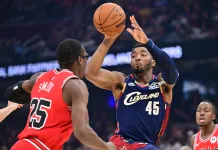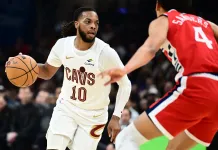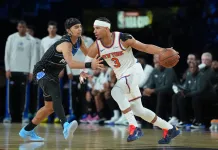NBA Finals – How to Approach Prop Betting:
The 2024-25 NBA Finals are set, and if the betting markets are any indication, we’re in for a one-sided series.
The Oklahoma City Thunder opened as massive -700 favorites at DraftKings to win the title over the Indiana Pacers, with -2.5 games priced at -140, a clear suggestion of a potential five-game series or sweep. Game One lines only reinforce the imbalance, with the Thunder laying 9.5 points at home and holding a dominant -425 moneyline. Oklahoma City swept the regular-season meetings, winning 132-111 on March 29 and 120-114 on December 26.
At the center of it all is MVP Shai Gilgeous-Alexander, who enters the Finals priced at -3500 to lead the series in points, -450 to average 30+ points per game, and -600 to win NBA Finals MVP. His Game One points prop is set at a lofty 33.5. While backing the Thunder and SGA looks justified based on dominance alone, the best betting opportunities may come by diving into the prop markets, particularly for role players and situational edges.
Target Overs on Bench Players
In what’s expected to be a lopsided NBA Finals series with multiple blowout scenarios, minutes for bench players should remain stable and potentially even expand in garbage time. Both Thunder coach Mark Daigneault and Pacers coach Rick Carlisle have trusted deep rotations throughout the postseason, and that trend should continue. This strategy paid off in the Western Conference Finals, where overs on players like Naz Reid, Donte DiVincenzo, Nickeil Alexander-Walker, Alex Caruso, and Cason Wallace all cashed.
Wallace stands out again in this series. His Game One points prop sits at 6.5, and he enters the Finals with the best individual Net Rating in the entire playoffs (+21.6). He also owns the best defensive rating (slightly ahead of Caruso) and has been one of the fastest-paced players on the floor—a major advantage against Indiana’s up-tempo attack. Wallace’s motor, defensive IQ, and ability to score in transition make him a strong over candidate.
On the Pacers’ side, Obi Toppin and Bennedict Mathurin—both listed at 7.5 points for Game One—offer similar upside. Each has thrived in fast-paced playoff environments (ranked one and two in individual pace) and should benefit from extended minutes off the bench, especially if Indiana is trailing early and often. Mathurin’s scoring aggression and Toppin’s ability to finish in transition make both attractive over candidates. The matchup data supports this: Oklahoma City has allowed the third-most shot attempts and sixth-most points per game to opposing benches this postseason. On the flip side, Indiana has allowed the third-most bench points per game (39.4). That opens up opportunities on both sides.
Fade Indiana Starters Early
While the Thunder have allowed some production to opposing benches based on game scripts, they’ve completely shut down starting units. Through the playoffs, Oklahoma City has allowed just 67.1 points per game to opposing starters—the fewest of any team—on just 42.3 percent shooting. They’ve also held starting units to 13.2 assists per game, again the lowest in the postseason. Their elite defense is anchored in limiting transition looks, forcing turnovers, and taking away primary options through tight rotations and help coverage. Opponents are averaging just 9.3 fast break points per game against them and committing 18.0 turnovers per contest —the fewest and most, respectively.
This spells trouble for Indiana’s starting lineup. While Tyrese Haliburton has posted impressive assist totals throughout the playoffs, he’ll face a defense that gives up the fewest assists to opposing starters. That introduces significant downside risk. The same goes for Pascal Siakam and Myles Turner, whose shot quality and efficiency will be tested by OKC’s size and defensive mobility.
Aaron Nesmith looks like the most vulnerable of the group. He currently leads all playoff players in true shooting percentage (67.1%), a mark that feels unsustainable given the matchup. OKC doesn’t give up many easy looks, and Nesmith will likely struggle to replicate his postseason output.
Watch for Sneaky Corner Three Opportunities
Despite their defensive excellence, Oklahoma City has shown some vulnerability on the perimeter, specifically on corner threes. The Thunder have allowed 12.4 corner three attempts per game in the playoffs, the second-most of any team. Opponents have shot just 31.2 percent on those looks, but volume often creates opportunity, especially when matched against a team that thrives from that spot.
The Pacers lead all remaining playoff teams by shooting 46.9 percent on corner threes this postseason. Nesmith is hitting 48.6 percent of his corner attempts (2.2 per game), and Ben Sheppard has quietly averaged 1.2 corner attempts himself. Both players, along with Mathurin and Toppin, are candidates to benefit from open looks created by defensive rotations and closeouts. In their two regular-season games against the Thunder, Nesmith, Mathurin, and Sheppard each averaged 3.0 corner three attempts. That type of usage should be noted heading into Game One.
One sneaky prop angle could be Sheppard over 0.5 made threes — a bet that will likely be priced affordably and could benefit from the expected defensive attention on Indiana’s primary creators. Mathurin and Toppin have also shown the ability to convert from the corners when left open, and this specific shot profile could be a key differentiator if Indiana finds any consistent offense in the halfcourt. Don’t go crazy here, though.
Final Thoughts
The betting market expects this series to be one-sided, but that doesn’t mean it’s lacking value. Prop bettors can thrive by targeting volume-based overs on bench contributors and fading Indiana’s starters early in the series. As the series shifts to Indiana, there may be more reason to back Pacers starters, but early on, staying sharp with these angles will be key. In what may be a short Finals, the long-tail value could lie in the box score’s middle and bottom rows, not the headlines.






